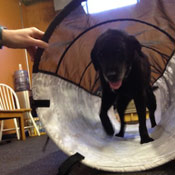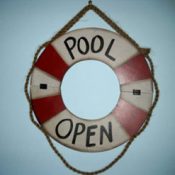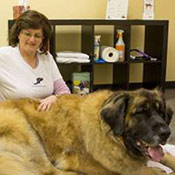-
Adopt
-
Veterinary Care
Services
Client Information
- What to Expect – Angell Boston
- Client Rights and Responsibilities
- Payments / Financial Assistance
- Pharmacy
- Client Policies
- Our Doctors
- Grief Support / Counseling
- Directions and Parking
- Helpful “How-to” Pet Care
Online Payments
Referrals
- Referral Forms/Contact
- Direct Connect
- Referring Veterinarian Portal
- Clinical Articles
- Partners in Care Newsletter
CE, Internships & Alumni Info
CE Seminar Schedule
Emergency: Boston
Emergency: Waltham
Poison Control Hotline
-
Programs & Resources
- Careers
-
Donate Now
Physical Rehabilitation
What is physical therapy for a dog?
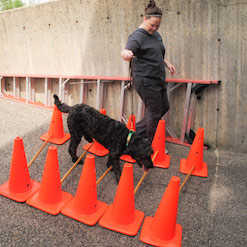 Canine rehabilitation, is much like physical therapy for humans. We adapt human physical therapy techniques to increase function and mobility, reduce pain, speed recovery from injury or surgery, and increase quality of life. As in humans, canine physical therapy is used to treat a wide variety of orthopedic and neurological conditions.
Canine rehabilitation, is much like physical therapy for humans. We adapt human physical therapy techniques to increase function and mobility, reduce pain, speed recovery from injury or surgery, and increase quality of life. As in humans, canine physical therapy is used to treat a wide variety of orthopedic and neurological conditions.
What happens in my first visit?
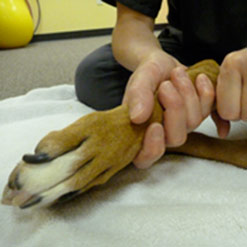 The first visit begins with a discussion to glean specific information about your pet and provide education so that you may better help your pet at home. We introduce you and your pet to our facility, helping you both to become comfortable in our setting and with our staff. Next, we perform baseline tests and measures to determine how physical rehabilitation may benefit your pet. If hydrotherapy is indicated, a short introductory swim will be included as time allows.
The first visit begins with a discussion to glean specific information about your pet and provide education so that you may better help your pet at home. We introduce you and your pet to our facility, helping you both to become comfortable in our setting and with our staff. Next, we perform baseline tests and measures to determine how physical rehabilitation may benefit your pet. If hydrotherapy is indicated, a short introductory swim will be included as time allows.
You will go home from the first visit with a recommended course of treatment as well as specific instructions and/or exercises.
If my dog has physical therapy at Angell, will this include swimming?
The evaluation determines what services are recommended for your pet. Age, diagnosis, other medical conditions, and client goals all impact your dog’s physical therapy prescription.
Non-weight-bearing exercise such as swimming is often an important part of the rehabilitation process. Our team has had great success transforming dogs who are uncomfortable or unfamiliar with the water into enthusiastic swimmers.
However, not every Angell client swims. Some or all of our other services, such as manual therapy, land-based exercise, and cold laser, may be more appropriate for your dog. During your initial evaluation, your physical rehabilitation specialist will discuss with you the services that are recommended, and work with you to develop the plan that is best for your dog.
How often will my dog need physical therapy?
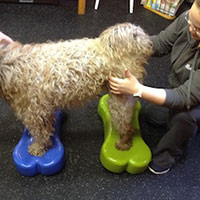 Most dogs come in weekly, with home care in between in order to maintain and even increase progress between appointments. Depending on your dog’s medical condition, your goals, logistics, and financial constraints, appointments could be anywhere from twice per week to once per month.
Most dogs come in weekly, with home care in between in order to maintain and even increase progress between appointments. Depending on your dog’s medical condition, your goals, logistics, and financial constraints, appointments could be anywhere from twice per week to once per month.
How soon after surgery can we start physical rehabilitation?
 The post-operative waiting period is determined by your dog’s surgeon, based on factors such as the type of surgery. In most cases, physical rehabilitation can begin 2-6 weeks after surgery. The sooner physical rehabilitation begins once your surgeon has determined it to be safe, the faster and more effective treatment will be.
The post-operative waiting period is determined by your dog’s surgeon, based on factors such as the type of surgery. In most cases, physical rehabilitation can begin 2-6 weeks after surgery. The sooner physical rehabilitation begins once your surgeon has determined it to be safe, the faster and more effective treatment will be.
In some cases, physical rehabilitation can be an alternative to surgery. Conditions that can often be managed non-surgically with proper rehabilitation include cruciate ligament tears, patellar luxations, hip dislocations and disc issues.
Who performs the physical rehabilitation evaluation and treatment?
A licensed physical rehabilitation specialist will perform your dog’s evaluation. Follow-up treatments may be administered by other members of our highly trained staff, which includes veterinary technicians and physical rehabilitation assistants.
Swimming
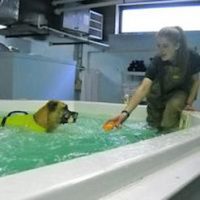 Swimming provides non-impact conditioning exercise that is easy on the joints. The properties of water are both assistive and resistive. It allows for greater freedom of movement and improved fitness and strength simultaneously. Swimming may be the only way a severely arthritic dog can exercise effectively since the buoyancy of the water counteracts gravity. Neurologically-impaired dogs can stand and move in the water when very difficult or impossible on land. Swimming is beneficial for cross-training for athletic dogs that run and jump such as in agility. The caloric expenditure is significant with swimming to promote weight loss when needed. Finally, Angell strongly believes that all dogs, like all children, should know how to swim for safety reasons. Even though you may never expect to take your dog swimming on your own, we have heard many stories over the years of dogs who fell into a body of water and sunk or panicked. Should this happen, it is imperative that your dog has the swimming skill to save itself.
Swimming provides non-impact conditioning exercise that is easy on the joints. The properties of water are both assistive and resistive. It allows for greater freedom of movement and improved fitness and strength simultaneously. Swimming may be the only way a severely arthritic dog can exercise effectively since the buoyancy of the water counteracts gravity. Neurologically-impaired dogs can stand and move in the water when very difficult or impossible on land. Swimming is beneficial for cross-training for athletic dogs that run and jump such as in agility. The caloric expenditure is significant with swimming to promote weight loss when needed. Finally, Angell strongly believes that all dogs, like all children, should know how to swim for safety reasons. Even though you may never expect to take your dog swimming on your own, we have heard many stories over the years of dogs who fell into a body of water and sunk or panicked. Should this happen, it is imperative that your dog has the swimming skill to save itself.
What if my dog is not a swimmer?
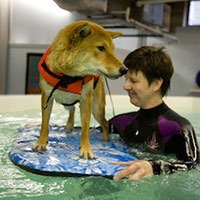
Photo by Fred Levy
Many of our dogs are not swimmers by nature, whether due to breed disposition, a traumatic experience, or simply never having been properly introduced to the water. Based on our vast experience we are able to positively encourage your pet’s participation in swimming. This involves using the life vest, an Angell staff member joining your pet in the pool as necessary, the caregiver’s support, lots of toys, and even a treat or two if necessary. Many who were hesitant to start have become fans, now begging and whining to swim upon arrival!
Why should my dog swim at Angell instead of a lake, pond, or the ocean?
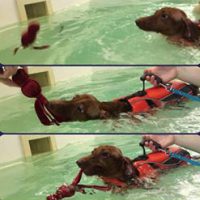 Angell allows your dog to enjoy the benefits of swimming year-round, in a clean, safe, and temperature-controlled environment. In outdoor bodies of water, exposure to bacteria and other organisms can lead to GI distress, skin conditions, and eye/ear infections. The most dangerous part of swimming is the entry and exit from the water. Jumping or leaping into water may lead to conditions such as swimmer’s tail. Because we often cannot see what is under the water’s surface, your dog could strike an object or become tangled. In the ocean, your dog may get caught up in unpredictable currents and riptides.
Angell allows your dog to enjoy the benefits of swimming year-round, in a clean, safe, and temperature-controlled environment. In outdoor bodies of water, exposure to bacteria and other organisms can lead to GI distress, skin conditions, and eye/ear infections. The most dangerous part of swimming is the entry and exit from the water. Jumping or leaping into water may lead to conditions such as swimmer’s tail. Because we often cannot see what is under the water’s surface, your dog could strike an object or become tangled. In the ocean, your dog may get caught up in unpredictable currents and riptides.
No. Angell policy does not permit anyone, except trained staff members, to enter the water with the pets. However, caregivers are encouraged to actively participate in their dogs swim session and are in the pool area cheering them on at all times.
Do you use chemicals in the pool?
Yes. Chemicals are required to keep the water safe for your pet and free of bacteria and fungus. We balance the water hardness, alkalinity, pH, and sanitizer (bromine) daily. Angell uses bromine in place of chlorine because it is more effective as a sanitizer in warm water, and gentler on the skin.
How many dogs swim at one time? Can my dogs swim together?
For the safety of all, only one pet is allowed in the pool at a time. This permits Angell staff to closely monitor your dog for the duration of their swim.
Why does my dog need a referral from a veterinarian to swim if they are healthy?
We require a referral to ensure your pet’s safety and communicate your intentions to swim your pet at Angell to the veterinarian. It is important that all professionals caring for your pet be aware of the services your pet is receiving.
Massage
I’d like to learn how to do more massage for my dog at home. Do you share your techniques?
Yes. We love when owners want to take up massage at home, and are happy to share tips on how and when to do so.
How frequently should my dog get a massage?
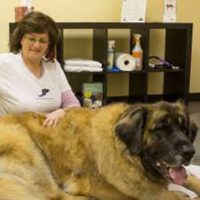 If a dog is struggling with pain or a mobility issue, it may be best to do massage once or twice a week. For younger dogs seeking massage as a preventive measure, once or twice a month may be right. During your initial session, we will talk about a plan for your dog’s health going forward.
If a dog is struggling with pain or a mobility issue, it may be best to do massage once or twice a week. For younger dogs seeking massage as a preventive measure, once or twice a month may be right. During your initial session, we will talk about a plan for your dog’s health going forward.
What should I expect after the massage?
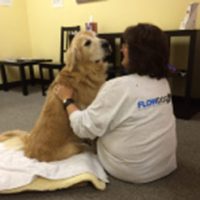 Immediately after a massage, your dog may feel thirsty and may need to relieve him or herself immediately afterward.
Immediately after a massage, your dog may feel thirsty and may need to relieve him or herself immediately afterward.
In the hours and days following a massage, your dog is likely to feel younger and move with greater ease.
Some dogs may experience isolated soreness, fatigue, or unsteadiness in the first 24-48 hours after a massage. This is a natural part of the process, and will subside as your dog integrates the work. If you have any questions or concerns, please contact us!
Is massage the same as petting?
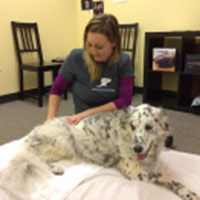 No. Petting is a superficial rubbing of a dog’s fur. On the other hand, massage therapy, performed by a Certified Small Animal Massage Therapist, is an intentional manipulation of the soft tissues and muscles to promote health and healing. The massage therapist uses precise techniques at specific depth and using a particular direction of movement to optimize the desired effect.
No. Petting is a superficial rubbing of a dog’s fur. On the other hand, massage therapy, performed by a Certified Small Animal Massage Therapist, is an intentional manipulation of the soft tissues and muscles to promote health and healing. The massage therapist uses precise techniques at specific depth and using a particular direction of movement to optimize the desired effect.
Do I need a vet referral to get a massage at Angell's PR service?
No. Unlike physical rehabilitation and swim sessions, massage can be given without a vet referral.
Yes. Anyone is welcome to book massage appointments with Angell’s PR service.
Some physical rehabilitation sessions do incorporate massage. However, in a dedicated massage session, your dog will enjoy concentrated manual treatment for a longer period of time, allowing for greater relaxation and muscle release.
